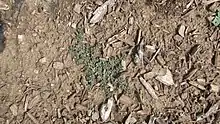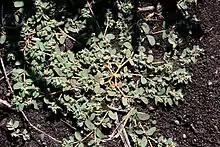Euphorbia maculata
Euphorbia maculata, known as spotted spurge, prostrate spurge (not to be confused with Euphorbia prostrata), milk purslane, or spotted sandmat, is a fast-growing annual plant in the family Euphorbiaceae. While it is native to North America, where it is a common garden and lawn weed in the United States, it has become a common introduced species throughout the world, including Europe, Japan, Korea, Australia, and New Zealand.[2]

| Euphorbia maculata | |
|---|---|
 | |
| Scientific classification | |
| Kingdom: | Plantae |
| Clade: | Tracheophytes |
| Clade: | Angiosperms |
| Clade: | Eudicots |
| Clade: | Rosids |
| Order: | Malpighiales |
| Family: | Euphorbiaceae |
| Genus: | Euphorbia |
| Species: | E. maculata |
| Binomial name | |
| Euphorbia maculata | |
| Synonyms[1] | |
|
List
| |
It grows in sunny locations and a variety of soils, and functions as a pioneer species in ecological succession. The sap of this plant is a mild skin irritant and can cause a rash in some people. The sap is poisonous and considered carcinogenic.[3][4]
Description
Euphorbia maculata is typically prostrate, with specimens rarely reaching up as high as 30 centimetres (12 in). The stems spread out in a mat along the ground with each stem rarely greater than 45 centimetres (18 in) long. The leaves are oval but rather elongate, up to 3 centimetres (1.2 in) long, and arranged in opposite pairs. The cyathia, bisexual reproductive structures unique to plants in the genus, are very small, with four white petal-like appendages that are sometimes pink.
The leaves are often marked with a reddish spot in the center, a feature that led to the common name of spotted spurge. It is similar to Euphorbia prostrata, but that species has shorter leaves that are more rounded at the tips. It may occasionally be confused with Euphorbia serpens but the very short and rounded leaves of E. serpens in combination with the larger (but still inconspicuous) cyathia should remove any potential for confusion.
References
- "Euphorbia maculata L." Plants of the World Online. Board of Trustees of the Royal Botanic Gardens, Kew. 2017. Retrieved 7 December 2020.
- "Euphorbia maculata". Global Biodiversity Information Facility. Retrieved 4 December 2022.
- Candice Miller. "Plants That Cause Skin Irritation" (PDF). University of Illinois Extension. Retrieved September 18, 2014.
- "Prostrate spurge". CSU/Denver County Extension. Retrieved September 18, 2014.
External links
- Missouriplants: Euphorbia maculata Archived 2018-10-01 at the Wayback Machine